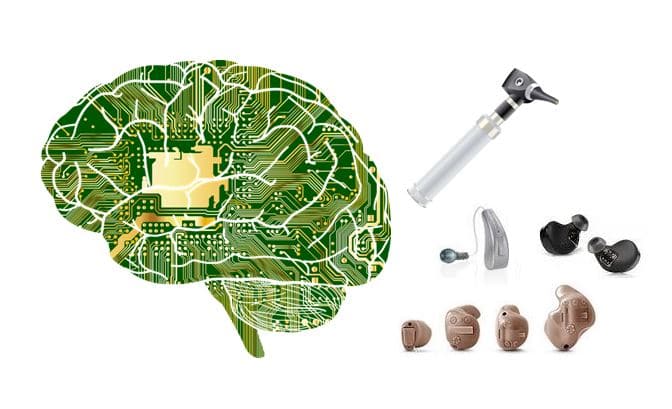Five-Year Outlook in the Hearing Aid Industry

Dr. Chris Heddon
What will the next five years look like in the hearing aid industry, and how does artificial intelligence (AI) fit into the future of hearing care?
There are several factors that will influence the hearing aid industry over the next five years to drive hearing aid prices down, increase the funds available for addressing hearing-related health issues, increase market penetration, and improve customer outcomes with improved hearing aids and hearing aid functionality.
A first significant factor affecting the hearing aid industry over the next five years is the introduction of OTC hearing aid sales and their effect on the price of hearing aids. With the OTC category soon opening in the US, On Semi, a major US-based manufacturer of chips for the global hearing aid industry, has released a system-on-a-chip platform that is specifically intended to allow startups and second-tier manufacturers to create hearing aids aimed at the OTC category in the US and the DTC Chinese market. If these new hearing aids, and others like them, gain traction in the mild hearing loss market (which is currently only 10% penetrated and makes up 75% of the overall market) and/or with value-conscious users who otherwise balk at the current average of $2,000 per hearing aid from premium first-tier manufacturers, there will be a sizeable downward shift in the price points of hearing aids.
Return rates on OTC hearing aids are expected to present a challenge to retailers; however, embracing the automated personalization that AI offers may be exactly what is needed to reduce device return rates to a sustainable level and allow the hearing aid prices to fall.
A second factor is the increased recognition of the economic and emotional burden that the co-morbidities of hearing loss present to our healthcare system, our seniors, and their families. The ongoing Baltimore Longitudinal Study of Aging by Dr. Frank Lin and colleagues at Johns Hopkins demonstrates that hearing loss is independently associated with an increased risk of dementia (2x increased risk dementia for mild hearing loss; 5x increased risk for severe hearing loss) and accelerated loss of brain tissue on MRI. In addition, Drs. Lin and Luigi Ferrucci,of the National Institute on Aging, have demonstrated that mild hearing loss is also associated with a three-fold increased risk of a fall, with a 1.4x increased risk for every additional 10dB of hearing loss.
Even if there were no other co-morbidities associated with hearing loss, a reduction in the risk of dementia and falls alone are likely enough to offset the cost of covering a sub-$1000 pair of hearing aids. It is likely that more health insurance payors will follow UnitedHealthcare’s lead in offering a full hearing aid benefit, especially with the lower price points that the OTC category will bring to the US market.
A third factor will be the extent to which modern hearing care practices embrace AI and tele-audiology as tools for increasing throughput and margin for clinic services and the extent to which hearing aid market penetration increases above today’s current 15% penetration rate.
There are several reason to be optimistic that the penetration rate will grow, including: (1) the expansion of DTC service delivery models (including the OTC category in the US); (2) the related reduction in device cost; (3) increasing health insurance coverage; and (4) new entrants into the hearing aid manufacturing market, particularly at the value-conscious end of the market. In today’s market, it takes around ten years for a person who could benefit from a hearing aid to actually purchase one. Lower cost, favorable form factors, and increased accessibility from pharmacies and online channels should reduce this adoption time.
Increased penetration in the value-conscious end of the market is likely to also lead to growth in the premium side of the market. Market data from commercial hearing aid pilots shows that, once a potential hearing aid consumer buys a value-focused hearing aid and sees a benefit, the customer is more likely to trade that model in for a premium hearing aid—the trade-in process ideally involving a referral to a hearing care practice for formal clinical exam.
Similarly, if an OTC hearing aid offers a hearing aid screening for initial device fitting, the screening may also include an automatic referral for a full clinic-based hearing evaluation. For example, a referral may be made any time the screening finds a greater than mild hearing loss, which is in line with AAA’s position with respect to OTC hearing aids.
A screening paradigm that refers greater-than-mild hearing loss patients for formal clinical exams is a very practical way to achieve AAA’s recommendation that OTC hearing aids be used only by people with mild hearing loss, as it is unlikely that a consumer with moderate-to-severe hearing loss that has had a formal audiology exam will choose to buy an OTC hearing aid indicated for mild hearing loss.
Based on these factors, the next five years in the hearing aid industry will see the price of hearing aids come down, an increase in the funds available for hearing-health expenses, an increase in market penetration, and an improvement in customer-patient outcomes.
What Does Artificial Intelligence Mean for the Practice of Audiology?
Hearing patients are being underserved by the current service delivery model, which to date has not had time to fully incorporate technologies like AI and device programming-over-air. Modern hearing care practices should embrace these emerging tools as a means of channeling underserved hearing patients to receive appropriate hearing care and increasing their bottom line.
For example, it is evident that many people who should be screened for hearing loss are simply not being screened. Surprisingly, the American Academy of Family Physicians still does not recommend hearing screenings for asymptomatic patients over the age of 50. The low rate of screening contributes to hearing aids’ low market penetration.
Factory calibrated OTC hearing aids that perform an AI-driven, mobile-based, hearing screening for fitting should be positioned, in partnership with hearing aid manufacturers, as a customer acquisition tool for modern audiology practices. In such a role, OTC hearing aid sales will increase the number of people receiving hearing screenings, increase the referrals to hearing care practices, and thereby improve the hearing outcomes for a greater percentage of the population.
The belief that the practice of audiology will change significantly with the introduction of intelligent, connected hearing aids is well-founded, but the idea that AI will steal market share from modern audiology practices is not.
Look at the recent troubles that Uber and Tesla’s self-driving car programs have had as evidence that complex tasks in ambiguous circumstances are best performed by humans. Audiology is no exception. By embracing the value that AI brings to the field, audiology practices can expand the reach of their services and improve the outcomes for their patients. This is the power of AI and this is what is best for our patients and the growth of the industry.








Manufacturers are desperate to show off new technology as a way to reboot their business. My research shows about 65% of hearing impaired people have abnormal middle ear functions that no one, repeat, no one has addressed to this day. This is the cause of the high return rate of 17%, wherein the clinician is flummoxed and cannot solve the hearing problem. Once the dynamics of middle ear pathologies are addressed, only then we need to move forward with AI. Otherwise its just a gimmick with a twist ! I have created solutions and am in touch with a hearing aid manufacture to create software changes that will help the 60% of hearing aid population that need help. So this fancy nonsense needs to get to the back burner until we have fully solved the remedies of middle ear functions.
It is interesting that most discussions about SFHA (self-fitting hearing aids) or OTC hearing aids by hearing professionals seem to unanimously predict that the return rate will be expected to be significantly higher than with conventionally-fitted hearing aids – but none provide any such statistics. In a recent conversation with one group selling such instruments via the Internet, I was given a return rate of 10%, which is significantly better than that of traditional hearing aid sales. Might this number have been given to me for self-serving purposes, or an anomaly? Perhaps. However, I have not found them to be misleading in past communications. It is quite possible that the return rate will depend on the ease with which the instrument can be fitted, its cosmetic and form, and not based on who is doing the fitting. The IKEA comments elsewhere in this week’s posts may serve as a good example.